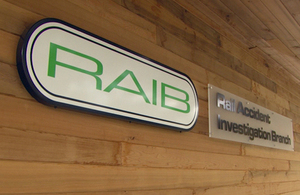Near-miss involving track workers near Hest Bank, Lancashire
Investigation into a near-miss incident involving a group of nine track workers on Monday 22 September 2014

The group were working on the West Coast Main Line, south of Hest Bank between Carnforth and Lancaster. The incident occurred at about 14:23 hrs.
The group, comprising contract staff and a controller of site safety employed by Network Rail, were packing ballast under sleepers on the up main line on a small bridge. A lookout operated warning system (LOWS) was being used to give warning of approaching trains because the gang’s view was restricted by curvature of the line. This system is designed to allow lookouts to signal the approach of a train by operating two toggle switches on a LOWS lookout unit. This then transmits a radio signal to a LOWS control unit which then gives both visual and audible warnings to the gang.
On the afternoon of the near-miss, the LOWS equipment was being operated by two Network Rail lookouts, one on each side of the site of work and each equipped with a LOWS lookout unit. The lookout watching for trains on the up line was located 780 metres (approximately 0.5 mile) from the site of work, in a position which gave him a good view of trains approaching from the north. The control unit was located near the track workers. The LOWS is reported to have been both tested and operating normally prior to the incident.
At about 14:23 hrs, a train, the 12:12 hrs Edinburgh to Manchester Airport service, approached the site from the north (on the up line). The group were provided with no advance warning that the train was approaching and were forced to take immediate evasive action when the train first became visible, approximately three seconds before it reached the site of work. Some staff were unable to reach a safe position and pressed themselves against the bridge parapet.
Update
The train was travelling at 98 mph (158 km/h) as it passed the group at a location where the maximum permitted speed is 125 mph (201 km/h).
Following examination of the LOWS equipment and its data-logger, and detailed testing, RAIB has concluded that it was working correctly at the time of the incident. With this in mind, our investigation will seek to understand the reasons why no warning was provided and any other factors that may have led to the incident, and identify any safety lessons.
Our investigation is independent of any investigations by the railway industry or safety authority (the Office of Rail Regulation) . We will publish our findings at the conclusion of the investigation. This report will be available on our website.
You can subscribe to automated emails notifying you when we publish our reports and bulletins.